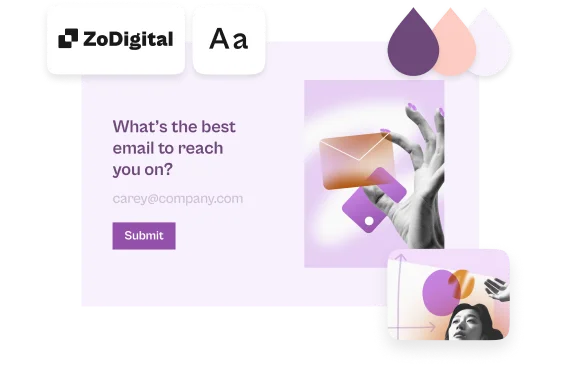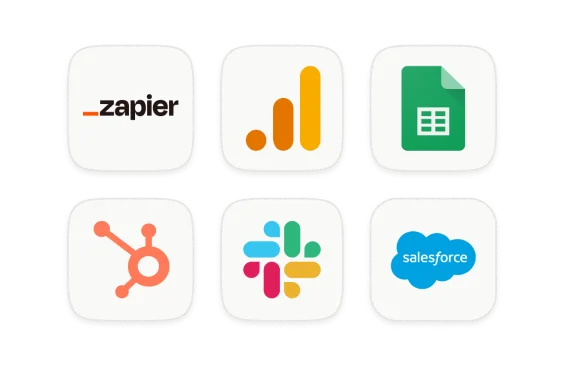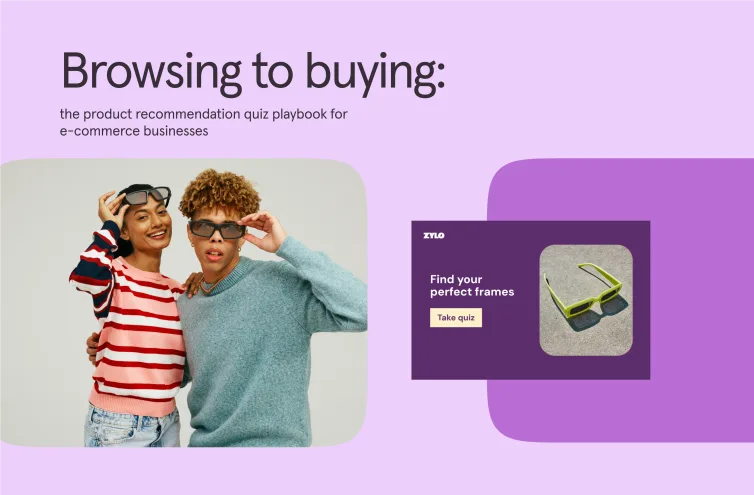Contents
01 Why (and how) we did this research 02 What makes a phenomenal form?03 data-backed ways to boost lead capture form performance04 Optimize the welcome screen05 Get up close and personal06 Collect contact info early07 Keep it positive08 Be brief, be bright, be gone09 Here’s a quick summary of our findings10 Lead capture is only the beginningFrom mattresses to marketing software, today’s buyers have options galore. But people aren’t making one-and-done decisions—they’re shopping around, reading reviews, and comparing your offering to the competition.
Brands need to build trust with audiences over time. When someone fills out a lead capture form, it’s the culmination of that person’s trust—and hopefully the start of their journey to becoming a future customer.
A lead capture form collects contact and basic information from a potential buyer so you can connect with them via email or text. The form opens the door for you to provide value or education, send discounts, and ask for feedback—all in service of building a relationship with interested and qualified leads.
Not all lead gen forms are created equal, though. So what makes an incredible lead generation form? What entices your prospects to continue answering your questions or simply walk away?
Latest posts on Tips
We set out to answer these questions by looking to the most reliable source: the data. We researched the features of effective forms, and we’re here to share our results. Keep reading for ways to grow your lead lists by creating lead forms that actually work according to our evaluation of 10,000 forms.
Why (and how) we did this research
At Typeform, we provide a simple, user-friendly form-filling experience that encourages respondents to finish every form. But we know there are always more ways to optimize lead gen forms for higher completion rates, from the length of the form to the tone of the text.
We wanted to identify which factors set apart a frequently completed typeform from one that sends users back to browsing their social media feeds instead.
To do this, we pulled a set of 10,000 typeforms. Each form was user-labeled as ‘lead capture,’ and each included an email or phone number field. To make sure we only analyzed actual lead-capture forms, we used a combination of hand-labeling and predictive modeling to identify 1,576 typeforms for our primary data set.)
All this to say, the recommendations we share here come from the completion rates and questions of actual Typeform users and their real-life leads.
What makes a phenomenal form?
Like many creative aspects of marketing, form-building can seem subjective. But the truth is, your audience instinctively knows a lousy form when they see one—and they’re far more likely to finish a good one.
The best way to gauge a form’s success is by looking at its completion rate. A high response rate means a form is accomplishing its purpose. In the case of lead generation forms, that’s collecting contact information.
Completion rates may vary depending on:
Form structure, such as how long or short the form is
Form text, such as the positive or negative sentiment in the language
Form context, such as how you invite users to complete the form
User context, such as form personalization for audience targeting
Our research explored the impact of each of these factors on form performance to find tried-and-true ways to keep your audience answering until the end. Building forms based on how your audience wants to engage maximizes response rates and improves form performance.
5 data-backed ways to boost lead capture form performance
Rather than forcing you to figure out the definitive features of a standout form by trial and error, we’ve done the trying-and-erroring for you—or, at least, the data gathering.
Here are our top five recommendations for boosting your completion rates and bringing in the leads you need to grow your pipeline and your business.
1. Optimize the welcome screen
You only have one chance to make a first impression within a form. Our research found that the welcome screen is a make-or-break moment for increasing the completion rate—and that means you need to aim for love at first click.
Set the scene
If someone fills out your lead capture form, you hope they’re qualified and eventually turn from a lead into a buyer. When a user arrives, reassure them they’re in the right place. On the welcome screen, offer context about why you’re gathering their information and what they can expect to gain as a result.
Jumping immediately into transactional questions translates to a less-than-friendly experience that can lead to dropoff. Case in point: We found that including a question on the welcome screen correlated with a 5% decrease in completion rate.
So roll out the welcome mat, and put your audience at ease by letting them know why they should complete your lead capture form. It’s an easy addition, and you’ll get more responses and more leads.
Capture attention right away
What can you offer your audience that no one else can? Do you have free resources or giveaways that show your expertise and give them value? Does your most recent research study share new statistics they won’t find anywhere else?
Use these magnets to entice your leads to fill out your form. “Exclusivity” language captures attention and shows your audience they get something of value after they complete the form—and that they’ll miss out if they don’t. Our data shows a 10.6% increase in form completion when the wording implied exclusivity.
Pro tip: Use your welcome-screen real estate to share an interesting fact or number that grabs attention or reminds them of their need for your helpful resource or product.
If you start well, you’re more likely to keep your audience engaged throughout your form until the very last question.
2. Get up close and personal
Personalization makes all the difference in convincing people to go the distance with a form. You make your audience feel like they’re on a journey, filling out a form made just for them with a few thoughtful key changes.
Use hidden fields
With hidden fields, you track information about respondents, segment your audience, and make your typeform even more personal and engaging. If you already have information like someone’s name or traffic source, populate the form with that information: “Thanks for stopping by from LinkedIn!”
Use tools like branching to send people down a specialized path based on their answers. That way, not everyone has the same experience—a responsive form experience shows you’re paying attention to the person behind the answers.
Through our research, we found that hidden fields correlated with a 4.8% increase in completion rate. We believe this is because marketers who use hidden fields think about the end user’s experience and find ways to remove the friction and hassle of form completion.
Put piping to work
When you get a marketing email that addresses you by name, don’t you feel just a bit more likely to read on because you feel like a real person is talking to you? Forms operate the same way.
When you use piping or variable features, your form recalls information someone has already provided. If you ask for their first name early on, a variable lets you auto-populate that information into text later in the form.
Maybe you want to include a message encouraging respondents when they’re in the home stretch. You could say: “We’re almost done gathering your information.”
Or, you could use piping to make it more friendly and personal: “Thanks, Carmen! We’re almost done gathering your information.” That small, personal touch calls back to what Carmen has already provided and makes them feel heard.
Our research says that piping also correlates with a 10% increase in form completion, and it takes your form personalization and experience to the next level.
3. Collect contact info early
Ah, yes. The all-too-precious contact info question. This is where you actually lock in that lead to drive greater awareness and education.
You might be tempted to leave this question for the end of your form to avoid seeming over-eager. But our research actually found the opposite to be effective—asking for the respondent’s email upfront correlates with higher completion rates.
We saw a whopping 18% increase in completion rates when the form asked for an email address first. The data is clear—the later you ask for an email address, the lower the completion rate.
This correlation might occur because when you ask for someone’s email address upfront, they feel invested right away. This can propel them through the rest of the form and encourage them to finish.
Don’t be afraid to jump right in and ask for that contact information. It’s a simple, straightforward question way to start (one that respondents don’t have to think hard about) and gives you the critical information you need. Wins all around!
4. Keep it positive
Think about it: Would you rather fill out a form that errs on the side of doom and gloom or stays upbeat? If you prefer a friendlier form, you’re in good company.
Our research found that positive sentiment in the text of forms—in the welcome screen, questions, and included statements—correlated with overall higher completion rates. We analyzed forms in the data set for positive or negative sentiment in three degrees: high, medium, and low.
Forms rated highly positive had 17% better completion rates than those rated highly negative. In addition, highly positive forms averaged 10% greater completion rates than forms that scored a low positive sentiment.
So what makes a positive form? Keep your greeting upbeat, and put forth a potential benefit for the respondent or others if they complete the form.
Even if the topic behind your form is urgent or you’re responding to an unfortunate event, keep the sentiment of your form on the lighter side as much as possible. If your reason for lead capture involves risky topics like health or disease, emphasize your purpose to drive positive outcomes and help them in the long-run.
When your audience feels optimistic about the reason for the form, they feel encouraged to finish rather than bogged down by the subject matter.
5. Be brief, be bright, be gone
Your audience is busy—we all are! It makes sense that a short, sweet, and to-the-point form would garner more responses than one that’s long or convoluted.
Keep your lead capture forms as brief as you can while still gathering the information you need. This isn’t the time to do an extensive background check on your respondent’s hope, dreams, and fears—you have plenty of time to ask more in-depth questions later in the relationship. For now, focus on the basics you need to stay in touch.
Our research found that the shorter the form, the higher the completion rate. For instance, 10-question forms averaged 28% lower completion rates than three-question forms.
Your form should take no more than two minutes to complete—but shoot for a completion time of under a minute. Another way to think about the length of your form is to try for six questions or less. Beyond that, respondents often feel overwhelmed or their attention may wander.
Here’s a quick summary of our findings
Don't ask a question on the welcome page. Our data revealed that this decreases completion rates by 5%.
Use piping to plug respondents’ names into your form. This practice saw a 10% increase in form completion rate.
Build personalized forms with hidden fields and branching. Respondents feel cared for, and they complete forms 4.8% more often as a result.
Ask for contact information upfront. Completion rates were 18% higher when the form asked for an email address first.
Stay positive with your form messaging as much as possible. Highly positive forms had 17% more completion than highly negative ones.
Keep lead capture forms short and sweet. Forms with three questions boasted 28% higher completion rates than forms with ten questions.
Lead capture is only the beginning
The goal of your lead-generation efforts shouldn’t be to gather as much information from as many people as possible. Instead, focus on building connections with people who are a good fit for your product and seek to help them.
You could have the best and most user-friendly form ever created, optimized to a T for high completion rates. But those efforts go to waste if you spam everyone who gives you their contact information, desperately trying to sell to the wrong audience.
If you’re out to play the long game, though—and you should be—offer relevant value to your leads and foster relationships built to last. If someone isn’t a good fit right now, they could recommend you to someone who is—or they might become the right fit one day. Until then, support and nurture your audience, showing them you’re dependable and supportive.
It’s not just capturing leads that counts—it’s how you treat them and what you do next.
Caring for your leads starts with a beautiful form they enjoy completing. Ready to put these tactics into practice and build refreshingly different lead capture forms? Typeform has you covered—let’s get started.







